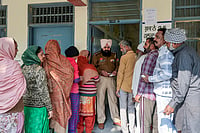And the toll has never been greater than in this century. In almost all industrialised economies today, where people—bureaucrats, executives, doctors, teachers, nurses, journalists, judges, lawyers, and drivers—spend most of their waking hours sitting rather than standing or walking, backache is the single largest cause of absenteeism after common cold.
India is no exception. Says Rajesh Malhotra, backpain specialist in Delhi's AIIMS: "We've all the clear and present dangers of modern living that make us prone to backaches—sedentary jobs and lifestyles; long commuting hours in buses and autos with back-breaking seats; smoking; lack of a fit-ness culture and bad postures. Little wonder, more than half the visitors to AIIMS' orthopaedic wards are patients of backpain."
Like C.D. Joshi, 42, an official in the defence ministry, who has been bed-ridden for the last six months following sharp backache. Despite treatment, there is no end to his pain. He's now thinking of premature retirement. His sin: obesity, long sitting hours, lack of exercise and bad posture.
Ditto for Kaveri Gupta, 37-year-old journalist, who can't sit for long without getting acute pain in the neck-region of her spine. She's been on medication and physiotherapy for the last many years. "The pain has changed my life drastically. I can't do things I loved doing once, like aerobics." As also for Mangala Pandey, a 30-year-old housewife, who has chronic backache. She can neither wash clothes nor stand in the kitchen for long. Laments she: "Back problems often mean giving up things in life you may not be willing to give up. These include your career, recreation, enjoyment of your family, even your sex life."
Likewise, there are others who are now paying heavily for neglecting their backs. While it makes life hell for the sufferer, backpain also makes a serious dent on a nation's GDP. In the US, backpain costs over $80 billion annually, while Britain loses about $4 billion over the same period. Nobody, however, has worked out monetary losses from backaches in India but Malhotra estimates it may run into millions of dollars.
The trouble about backaches is nobody takes them seriously till they become a 'problem'. Explains Chandra K. Bhatia, a private spine surgeon: "Most backaches are minor with no serious underlying cause. But, if ignored, these 'minor' aches eventually snowball into a fulminant backache."
The human spine is vulnerable enough. It's made worse by ignorance, laziness and a cavalier attitude. Sitting for prolonged periods without getting up or doing some stretching; hunching over the desk without using back support of your chair; slouching on the sofa; bending over to lift a heavy weight without bending at the hips and knees; doing vigorous exercises without warm-up or after a long gap; letting back and abdominal muscles idle—all these increase the strain on the back muscles.
However, diagnosing what exactly is wrong with one's back is one of the most difficult challenges in medicine today. Says Malhotra: "It's a guessing game. After suspects such as TB, kidney infection, osteoporosis, hernia and cancer have been eliminated, both patient and doctor wonder if the pain's coming from an injury to the joint, the disc, ligaments, or muscles. For most patients, we may never know, despite technological advances such as the MRI."
Sprains and strains are some of the most common back ailments. Doctors describe muscles as strained; joints and ligaments as sprained. They occur when you bend the spine too far in any direction, or bend repeatedly, or put too much load on the spine in a bent position. This may result in a muscle or ligament tear. We do this to ourselves every day, but we don't feel pain unless we do enough damage to cause bleeding or inflammation. This damage usually will heal itself, but it often creates a weak scar-tissue, which leaves us stiffer and weaker in that area. "Then one day," enlightens Bhatia, "as we bend forward, we tear a large portion of muscle or ligament, resulting in severe pain and inflammation. This time the injury may not heal adequately, leaving that part of the spine more vulnerable to injury."
Much of the problem arises because we were not made to stand upright (you only have to look at the guerrilla or the chimp to appreciate this subtlety!).The spine is a flexible column of 33 interlocking bones, and has two basic functions. First, it must be highly mobile to allow bending and twisting in all directions over a wide range of motion. Second, it must be very stable in order to maintain upright posture all day long. "It is very difficult for any part of your skeleton to be both mobile and stable. This is mechanically very challenging and makes the spine vulnerable to injury," remarks Bhatia.
We make matters worse for our spine by letting back and stomach muscles idle. Emotional stress is yet another enemy of the back. It adds to fatigue and robs one of flexibility. Smoking is no friend either. Studies in the US suggest that nicotine may render lower back prone to soft tissue injury. Remember, there are no permanent cures for chronic backaches. "At best we can alleviate the suffering with pain-relievers and physiotherapy. By far the best cure for most mechanical backaches is complete bed rest for 3-4 days followed by physiotherapy," recommends Bhatia. However, patients still flock to alternative healers—masseurs, chiropractors,acupuncturists and manipulators—for relief. Malhotra believes that while these methods have their benefits, administered by the wrong hands, they may do more damage than good. "The problem in India is there are no standards regulating their practice," he adds.
Orthodox treatments, such as traction, massage, biofeedback, injections into the back, back corsets, and ultrasound exist, do help, but, warns Malhotra, "none have been found to speed recovery or keep acute back problems from returning. Besides, they are expensive." Surgery should be the last option, says Malhotra.
"Surgery has been found to be helpful in only 1 in 100 cases of low back problems. In fact, it can make the problem worse in some patients," he adds.
All said and done, there are no permanent fixes for backaches. If you want to live long without a nagging back, follow this prescription: work your back and abdominal muscles regularly, eat well, worry less, cut down on smoking, and yes, whenever you bend, lift weight or slouch, think of your poor back!


























